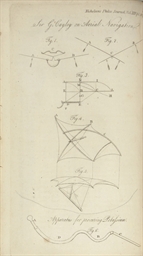KEPLER, Johannes. Epitome astronomicae Copernicanae [libri I. II. III] de doctrina sphaerica. Linz: Johann Planck, 1618. - Epitomes astronomiae Copernicanae Liber quartus. Doctrinae theoricae primus: quo physica Coelestis. Linz: Johann Planck, 1620. - Epitomes astronomiae Copernicanae libri V. VI. VII. quibus proprie doctrina theorica. Frankfurt: for Gottfried Tampach, 1621.
KEPLER, Johannes. Epitome astronomicae Copernicanae [libri I. II. III] de doctrina sphaerica. Linz: Johann Planck, 1618. - Epitomes astronomiae Copernicanae Liber quartus. Doctrinae theoricae primus: quo physica Coelestis. Linz: Johann Planck, 1620. - Epitomes astronomiae Copernicanae libri V. VI. VII. quibus proprie doctrina theorica. Frankfurt: for Gottfried Tampach, 1621. 3 parts in one, 8 o (156 x 93 mm). Woodcut illustrations, head- and tail-pieces, and initials. Folding letterpress table, letterpress tables in the text. (Some light browning and staining, 4C5 with short marginal tear.) Contemporary vellum (covers slightly bowning). FIRST EDITIONS, "KEPLER'S LONGEST AND MOST INFLUENTIAL WORK" ( DSB ). Following the publication of his Astronomia nova in 1609, Kepler was asked to write a more popular exposition of Copernican astronomy; however, "despite its title, Kepler's Epitome was more an introduction to Keplerian than to Copernican astronomy" ( op. cit. ). The work was written during a period of upheaval (Kepler's mother had been charged with witchcraft and threatened with torture, and the first volume's advocacy of the Copernican system soon earned it a place on the Index librorum prohibitorum ), and the seven books were issued in three inexpensive octavo volumes, titled "Doctrina spherica," "Physica coelestis," and "Doctrina theorica," over a period of some three years. Intended to be an easily-comprehensible textbook of the new heliocentric astronomy, the Epitome was laid out in a catechetical form which imparted the information through questions and answers, employing a technique typical of many astronomical textbooks of the period. Beyond its stated educational purpose, the Epitome also expanded on Copernican theory -- with regard to the motions of the earth, Kepler extended Copernicus' work and correctly formulated the principles which Galileo would in turn discuss in more detail in his Dialogo of 1632 -- and served to enlarge upon Kepler's own work: "the most remarkable section ... was book IV, on theoretical astronomy, subtitled, 'Celestial Physics' ... to a great extent it epitomized both the Harmonice mundi [of 1619] and the new lunar theory that Kepler completed in April 1620 ... The harmonic law, which Kepler had discovered in 1619 and announced virtually without comment in the Harmonice mundi, received an extensive theoretical justification in the Epitome ' (op. cit., p. 303). Carli & Favaro 76 and 92 (vols I and II); Caspar 55, 69 and 66; Cinti 60, 72, and 67; Houzeau & Lancaster 11831.
KEPLER, Johannes. Epitome astronomicae Copernicanae [libri I. II. III] de doctrina sphaerica. Linz: Johann Planck, 1618. - Epitomes astronomiae Copernicanae Liber quartus. Doctrinae theoricae primus: quo physica Coelestis. Linz: Johann Planck, 1620. - Epitomes astronomiae Copernicanae libri V. VI. VII. quibus proprie doctrina theorica. Frankfurt: for Gottfried Tampach, 1621.
KEPLER, Johannes. Epitome astronomicae Copernicanae [libri I. II. III] de doctrina sphaerica. Linz: Johann Planck, 1618. - Epitomes astronomiae Copernicanae Liber quartus. Doctrinae theoricae primus: quo physica Coelestis. Linz: Johann Planck, 1620. - Epitomes astronomiae Copernicanae libri V. VI. VII. quibus proprie doctrina theorica. Frankfurt: for Gottfried Tampach, 1621. 3 parts in one, 8 o (156 x 93 mm). Woodcut illustrations, head- and tail-pieces, and initials. Folding letterpress table, letterpress tables in the text. (Some light browning and staining, 4C5 with short marginal tear.) Contemporary vellum (covers slightly bowning). FIRST EDITIONS, "KEPLER'S LONGEST AND MOST INFLUENTIAL WORK" ( DSB ). Following the publication of his Astronomia nova in 1609, Kepler was asked to write a more popular exposition of Copernican astronomy; however, "despite its title, Kepler's Epitome was more an introduction to Keplerian than to Copernican astronomy" ( op. cit. ). The work was written during a period of upheaval (Kepler's mother had been charged with witchcraft and threatened with torture, and the first volume's advocacy of the Copernican system soon earned it a place on the Index librorum prohibitorum ), and the seven books were issued in three inexpensive octavo volumes, titled "Doctrina spherica," "Physica coelestis," and "Doctrina theorica," over a period of some three years. Intended to be an easily-comprehensible textbook of the new heliocentric astronomy, the Epitome was laid out in a catechetical form which imparted the information through questions and answers, employing a technique typical of many astronomical textbooks of the period. Beyond its stated educational purpose, the Epitome also expanded on Copernican theory -- with regard to the motions of the earth, Kepler extended Copernicus' work and correctly formulated the principles which Galileo would in turn discuss in more detail in his Dialogo of 1632 -- and served to enlarge upon Kepler's own work: "the most remarkable section ... was book IV, on theoretical astronomy, subtitled, 'Celestial Physics' ... to a great extent it epitomized both the Harmonice mundi [of 1619] and the new lunar theory that Kepler completed in April 1620 ... The harmonic law, which Kepler had discovered in 1619 and announced virtually without comment in the Harmonice mundi, received an extensive theoretical justification in the Epitome ' (op. cit., p. 303). Carli & Favaro 76 and 92 (vols I and II); Caspar 55, 69 and 66; Cinti 60, 72, and 67; Houzeau & Lancaster 11831.















Testen Sie LotSearch und seine Premium-Features 7 Tage - ohne Kosten!
Lassen Sie sich automatisch über neue Objekte in kommenden Auktionen benachrichtigen.
Suchauftrag anlegen